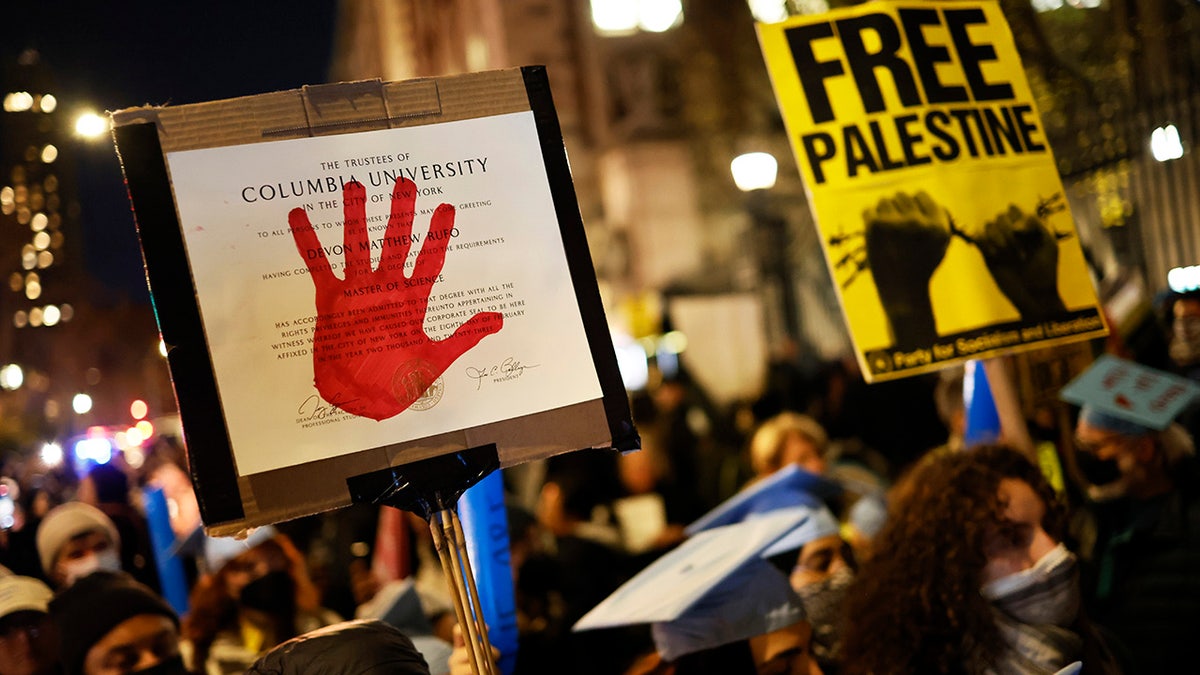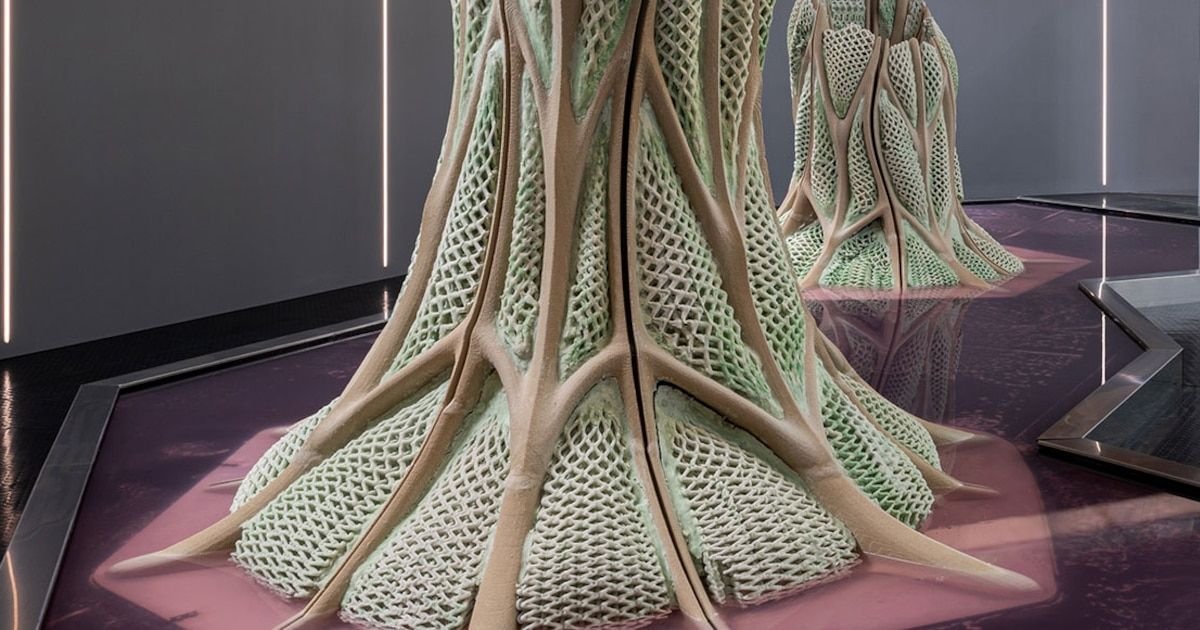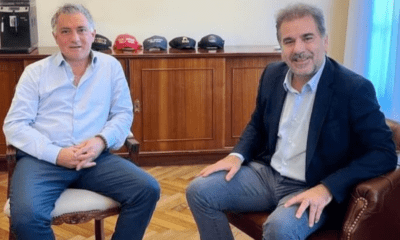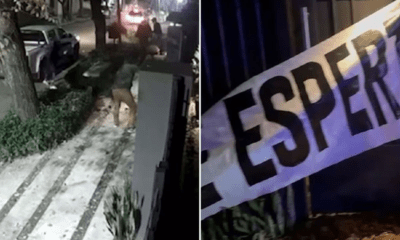INTERNACIONAL
Lawsuit alleges anti-Israel group leaders are ‘Hamas’ foot soldiers in New York City’

A lawsuit filed in the Southern District of New York last month claims the leaders of several radical anti-Israel groups involved in 18 months of disruptive, violent and antisemitic protests on campuses and in the streets of New York City are «accountable for aiding and abetting Hamas’ continuing acts of international terrorism.»
In purported violation of the Antiterrorism Act and the Alien Tort Statue, the defendants are said to have «acted as Hamas’ foot soldiers in New York City,» and may have had foreknowledge of the designated foreign terror organization’s devastating Oct. 7 attacks.
Defendants in the case are Within Our Lifetime and its founder Nerdeen Kiswani, Columbia Students for Justice in Palestine (SJP) and its representative Maryam Alwan, Columbia-Barnard Jewish Voice for Peace (JVP) and its representative Cameron Jones, and Columbia University Apartheid Divest (CUAD) and its representative Mahmoud Khalil, who is currently in custody of Immigration and Customs Enforcement (ICE).
The lawsuit asserts that the associational defendants have «distribute[d] Hamas-created and affiliated propaganda, incite[d] fear and violence, and attack[ed] critical academic, economic, and infrastructure centers in New York City,» as well as having «repeatedly terrorized and assaulted Jews across New York City and on Columbia University’s campus, physically assaulted Columbia University employees, and illegally seized and damaged public and private property.»
DUFFY SLAMS MTA OVER ‘FACT CHECK’ ON ANTI-ISRAEL MOB’S GRAND CENTRAL TAKEOVER
Nerdeen Kiswani, co-founder and leader of Within Our Lifetime, speaks at a demonstration near Columbia University on Feb. 2, 2024, in New York City. (Alexi J. Rosenfeld/Getty Images)
The details of the allegations are thorough. To demonstrate how the defendants «resoundingly and knowingly answered Hamas’ call to action» on and after Oct. 7, the lawsuit cites how the defendants knowingly «obtain[ed] and disseminat[ed]» a Hamas propaganda document, which contained directions created by the Hamas Media Office for spinning the narrative of their deadly attacks. By «painstakingly follow[ing]» the document, the lawsuit alleges defendants «directly responded to, and followed orders from, Hamas.»
The lawsuit also supplies several indicators that defendants may have had foreknowledge of the heinous Oct. 7 attack, to include «a highly suggestive social media post published moments before the October 7 attack began» in which Columbia SJP posted on Instagram «We are back!!» after a months-long hiatus.
On Oct. 7, Kiswani utilized marketing materials that «would not be released until the next day» in a National Students for Justice in Palestine (NSJP) «Toolkit» demonstrating how SJP organizations across the country could support the Gazan «resistance.»

Emaciated Israeli hostages, from left, Ohad Ben Ami, Eli Sharabi and Or Levy are taken by terrorists to a stage before being handed over to the Red Cross in Deir al-Balah in the central Gaza Strip on Feb. 8, 2025. (AP/Abdel Kareem Hana)
Following Oct. 7, Within Our Lifetime promoted a «Day of Rage» in New York City while Columbia SJP and Columbia JVP promoted their own «Day of Resistance.» The mere announcements of these events forced closures of Jewish schools and institutions, and «even forced Columbia University – a non-Jewish institution – to close its campus as a safety precaution,» while Jewish students «were advised to lock their doors and remain inside for their own safety,» according to the lawsuit.
The lawsuit names Khalil as the purported leader of Columbia SJP’s Day of Resistance.
COLUMBIA’S ANTI-ISRAEL PROTESTERS SAY TRUMP PULLING $400 MILLION IN GRANTS FROM UNIVERSITY IS A ‘SCARE TACTIC’
In November 2023, the suit describes how a «’Shut it Down for Palestine’ event descended into – as planned – anti-Jewish and vitriolic hatred and threats,» with speakers shouting «Death to Jews!» and «encourage[ing] Hamas and… comrades across Columbia’s campus to hunt down and assault pro-Israel students.»
The next day, Columbia University suspended Columbia SJP and Columbia JVP, at which time «Khalil and former members and/or organizers of Columbia SJP became leaders of CUAD.» As a result, CUAD «became the primary organizer of the violent and antisemitic protests that would foment terror, sow discord, and disrupt campus life at Columbia for over a year.»

Hamas terrorists kidnap a bloodied Israeli woman into the Gaza Strip. (Hamas-Telegram)
Khalil would later become the lead negotiator of the Columbia encampment, which the lawsuit notes was «well-supplied with identical tents, toiletries, food, and professional signage.» Based on a statement from Shlomi Ziv, a plaintiff in the lawsuit who was held captive by Hamas for 246 days following his kidnapping at the Nova Music Festival, «Hamas and [American Muslims for Palestine (AMP)]/NSJP provided financial, organizational, and other support… for the Encampment.»
Ziv alleges that his «Hamas captors bragged about having Hamas operatives on American university campuses,» and even «showed him Al-Jazeera stories and photographs of protests at Columbia University that were organized by Associational Defendants.»
APPARENT ANTI-ISRAEL ACTIVISTS SPLASH RED PAINT ON HOMES OF JEWISH OFFICIALS AT BROOKLYN MUSEUM

Anti-Israel demonstrators attend a protest at Columbia University in New York City, just days after the Hamas slaughter in southern Israel, Oct. 12, 2023. (Julia Bonavita/Fox News Digital)
Given the «legal chasm between independent political advocacy and coordinating with a foreign terrorist organization to seed pro-terror propaganda throughout America’s largest city,» the lawsuit alleges the defendants’ «actions violate the Antiterrorism Act and the law of nations.»
According to the Jerusalem Post, the National Jewish Advocacy Center, Greenberg Traurig LLP, the Schoen Law Firm, and the Holtzman Vogel Law Firm filed the suit on behalf of plaintiffs who include Ziv, several Columbia University students who have served with the Israel Defense Forces, and a number of American and Israeli citizens whose family members, most of whom are believed dead, remain in Hamas captivity.

People protest the banning of Students for Justice in Palestine and Jewish Voice for Peace at Columbia University on Nov. 20, 2023 in New York City. (Michael M. Santiago/Getty Images)
The lawsuit especially states that Khalil, «on information and belief, directly coordinates with Hamas, AMP/NSJP and/or other agents and affiliates of Hamas and related terrorist organizations.» The filers state that his detention by ICE in March may have been «based on many of his actions described in this Complaint.»
Khalil’s involvement in the Columbia protests was cited as a rationale for his removal during his April 11 hearing, when Judge Jamee Comans ruled that Khalil may be deported. Khalil also withheld past employment with the Syrian office in the Beirut British Embassy and the United Nations Relief and Works Agency for Palestine Refugees in the Near East (UNRWA) as well as his membership in the CUAD when applying for a green card.
This withholding of information, according to federal officials, made Khalil «inadmissible at the time of his adjustment.»
CLICK HERE TO GET THE FOX NEWS APP
Disruptive events in New York City show no signs of abating. In March, students stormed a classroom at Columbia University and took over a building in affiliated Barnard College, where they assaulted an employee. A Within Our Lifetime protest on April 7 «took over» the main concourse of Grand Central Station.
Fox News Digital reached out to CUAD, Columbia SJP, Within Our Lifetime, and Columbia-Barnard JVP for comment about the allegations contained within the lawsuit, but received no response.
INTERNACIONAL
Un hidrogel con cianobacterias podría ser una solución para combatir el cambio climático

Un material puede hacer que las paredes de un edificio ayuden a limpiar el aire que las rodea y a mitigar el problema del cambio climático. Eso no es magia: es el resultado de un avance científico real realizado en una universidad pública de Suiza.
Fue realizado por investigadores de ETH Zurich, la institución que fue fundada en 1855 y tuvo como alumnos al físico Albert Einstein y a otros 21 ganadores de Premios Nobel. Incluyeron cianobacterias dentro de un hidrogel, que es un polímero inerte, y obtuvieron un material vivo artificial.
El nuevo material es capaz de capturar dióxido de carbono (CO₂) de manera eficaz, mientras genera minerales que lo almacenan de forma estable. Los resultados fueron publicados en la revista Nature Communications.

Significa que, además de transformar el CO2 en biomasa a través de la fotosíntesis, las cianobacterias inducen la formación de minerales y así se consigue un almacenamiento mucho más duradero y seguro del carbono capturado en el propio material.
Consideran que la innovación podría ofrecer una solución escalable y sostenible que elimina el CO₂ de la atmósfera al emplear procesos naturales.

El dióxido de carbono siempre ha estado presente en la atmósfera. Es parte natural del aire que se respira y del ciclo del carbono del planeta.
Pero su presencia aumentó por actividades humanas como la quema de combustibles fósiles (petróleo, gas, carbón) y la deforestación.
Este exceso de CO₂ atrapa calor en la atmósfera y eso condujo a que las temperaturas globales suban, los glaciares se derritan, los océanos se calienten, entre otros impactos.
El CO₂ no es “malo” en sí mismo: las plantas lo necesitan para hacer fotosíntesis. Pero en exceso desequilibra el sistema.
Científicos de todo el mundo buscan formas efectivas de capturar ese CO₂ para defender la salud del planeta.

La mayoría de los métodos conocidos hasta ahora son costosos, requieren mucha energía o no consiguen guardar el carbono durante mucho tiempo.
Algunos grupos han probado con técnicas químicas y otros con organismos vivos como plantas y algas.
Pero, hasta este avance, no se había combinado con éxito un material inerte y un organismo vivo que sigue activo dentro del hidrogel y tiene capacidad de almacenar carbono en formas estables.
El equipo de ETH Zurich decidió enfrentar el desafío de hacer algo muy diferente.

Para fabricar el nuevo material, el equipo usó un hidrogel, que es como una esponja blanda hecha con polímeros. Este gel deja pasar agua, luz y CO₂.
Dentro del hidrogel colocaron millones de cianobacterias, microorganismos que viven en la Tierra desde hace millones de años y pueden hacer fotosíntesis.
Las cianobacterias usan la luz solar para transformar el CO₂ del aire en alimento y oxígeno. También producen una reacción especial: su actividad provoca la formación de minerales sólidos, como la cal, que guarda el CO₂ por mucho tiempo dentro del gel.
El equipo utilizó impresión 3D para dar forma al material y optimizar la entrada de luz, agua y nutrientes. Así crearon piezas y bloques que funcionan bien para proyectos grandes.

Dalia Dranseike, quien fue primera autora del trabajo junto con Yifan Cui, explicó: “El material tiene estructuras que dejan pasar luz y distribuyen el líquido con nutrientes gracias a la capilaridad”.
El material logró resultados increíbles: en el laboratorio, pudo atrapar CO₂ de forma constante durante 400 días.
Cada gramo retuvo 26 miligramos de CO₂, y superó a otros métodos como el llamado “hormigón reciclado”. Los minerales que se forman en su interior vuelven el material más fuerte y resistente.
Las posibles aplicaciones van más allá de los experimentos. Los investigadores imaginan que el nuevo material se podría usar en edificios, fachadas y objetos urbanos para limpiar el aire y ayudar a combatir el cambio climático.

Después de los éxitos en el laboratorio, el equipo de ETH Zurich llevó su material a exposiciones internacionales de arquitectura. Andrea Shin Ling, arquitecta y miembro del equipo, fue clave en este paso.
En la Bienal de Arquitectura de Venecia montaron troncos de hasta tres metros de alto, formados por el material vivo que contiene cianobacterias. Cada tronco puede capturar 18 kilos de CO₂ por año, similar a lo que absorbe un pino adulto.
La arquitecta contó que el mayor desafío fue escalar el proceso, ya que fabricar piezas grandes es muy diferente al trabajo de laboratorio.
En tanto, en la Trienal de Milán, cubrieron tejas de madera con el hidrogel y las cianobacterias. Con el tiempo, formaron una “piel” verde sobre la madera, un signo claro de que las bacterias seguían vivas y activas capturando CO₂.
Observar el cambio de color y el trabajo de las cianobacterias resultó emocionante para el equipo.

En diálogo con Infobae, la doctora Graciela Salerno, investigadora superior del Conicet en cianobacterias y biotecnología, profesora emérita de la Universidad Nacional de Mar del Plata y vicepresidente del Comité Ejecutivo de la Fundación para Investigaciones Biológicas Aplicadas (FIBA), comentó: “Se busca desde hace varias décadas en diferentes laboratorios, el desarrollo de métodos de secuestro de dióxido de carbono a través de materiales fotosintéticos”.

Tras leer el estudio publicado en Nature Communications, la doctora Salerno, quien no participó en la investigación, opinó que los investigadores de Suiza “le han dado una vuelta interesante y desarrollaron una innovación que combina el poder de las cianobacterias con ingeniería de materiales”.
Además, la científica expresó: “Si bien falta aún escalar la producción y evaluar su implementación práctica, el hidrogel podría ser una estrategia más para combatir al cambio climático. Por supuesto, también se necesita que se reduzcan las emisiones de gases de efecto de invernadero para no seguir agravando el problema”.
INTERNACIONAL
Para Bezos y Sánchez, una boda de secretos que todos conocen

Manejos
Controles
INTERNACIONAL
Senate shuts down Kaine’s attempt to check Trump’s war powers

What is the War Powers Act?
UC Berkeley Law professor John Yoo discusses U.S. strikes on Iran and the War Powers Act on ‘Life, Liberty & Levin.’
NEWYou can now listen to Fox News articles!
A Senate Democrat’s push to put a check on President Donald Trump’s powers and reaffirm the Senate’s war authority was shut down by lawmakers in the upper chamber Thursday.
Sen. Tim Kaine’s war powers resolution, which would have required Congress to debate and vote on whether the president could declare war, or strike Iran, was struck down in the Senate on a largely party-line vote, save for Sen. John Fetterman, D-Pa., a staunch advocate of Israel who supported Trump’s strike on the Islamic Republic, and Sen. Rand Paul, R-Ky., who has been vocal in his thoughts about congressional war powers in recent days.
Earlier in the week, the Virginia Democrat vowed to move ahead with the resolution despite a fragile ceasefire brokered between Israel and Iran following weekend strikes on the Islamic Republic’s key nuclear facilities that were not given the green-light by Congress.
DEM SENATOR PLOWS AHEAD WITH WAR POWERS RESOLUTION DESPITE CEASEFIRE
The White House said the president’s advisors would urge him to veto Kaine’s resolution. (Reuters)
Kaine argued that the ceasefire gave his resolution more credence and breathing room to properly debate the role that Congress plays when it comes to authorizing both war and attacks abroad.
He said ahead of the vote on the Senate floor that he came to Washington to ensure that the country does not again get into another «unnecessary» war, and invoked the rush to approve war powers for President George W. Bush over two decades ago to engage with Iraq.
«I think the events of this week have demonstrated that war is too big to consign to the decisions of any one person,» Kaine said.
‘NOT CONSTITUTIONAL’: CONGRESS EVOKES NEW WAR POWERS RESOLUTION TO REJECT TRUMP’S STRIKES ON IRAN

Senate Majority Leader John Thune speaks during a news conference following the weekly Senate Republican policy luncheon at the U.S. Capitol on June 17, 2025. (Getty Images)
Indeed, his resolution became a focal point for a debate that has raged on Capitol Hill since Israel began its bombing campaign against Iran: whether the strikes like those carried out during Operation Midnight Hammer constituted an act of war that required congressional approval, or if Trump’s decision was under his constitutional authority as commander in chief.
CLICK HERE TO GET THE FOX NEWS APP
Senate Republicans have widely argued that Trump was well within his purview, while most Senate Democrats raised constitutional concerns about the president’s ability to carry out a strike without lawmakers weighing in.
Experts have argued, too, that Trump was within his executive authority to strike Iran.
The Constitution divides war powers between Congress and the White House, giving lawmakers the sole power to declare war, while the president acts as the commander in chief directing the military.
And nearly two centuries later, at the height of the Vietnam War, the War Powers Resolution of 1973 was born, which sought to further define those roles.
But the most impact lawmakers could have is through the power of the purse, and Sen. Mitch McConnell, R-Ky, who plays a large role in controlling the purse strings as the Senate Appropriations Subcommittee on Defense, had a sharp message against Kaine’s resolution.
McConnell used instances where Democratic presidents over the last three decades have used their authority for limited engagements in Kosovo, Libya, Syria and Yemen, and questioned why «isolationists» would consider the strike on Iran to kneecap its nuclear program a mistake.
«I have not heard the frequent flyers on War Powers resolutions reckon seriously with these questions,» he said. «Until they do, efforts like this will remain divorced from both strategic and constitutional reality.»
-

 POLITICA1 día ago
POLITICA1 día agoDesconfianza de los intendentes del PRO sobre el avance de las negociaciones con LLA: “Hasta ahora nadie acercó una propuesta”
-

 POLITICA2 días ago
POLITICA2 días agoJavier Milei apuntó duro al Chiqui Tapia por la eliminación de River y Boca: “Le hace mal al fútbol”
-

 POLITICA2 días ago
POLITICA2 días agoDetuvieron a una funcionaria del Ministerio de la Mujer bonaerense por el ataque a la casa de José Luis Espert























